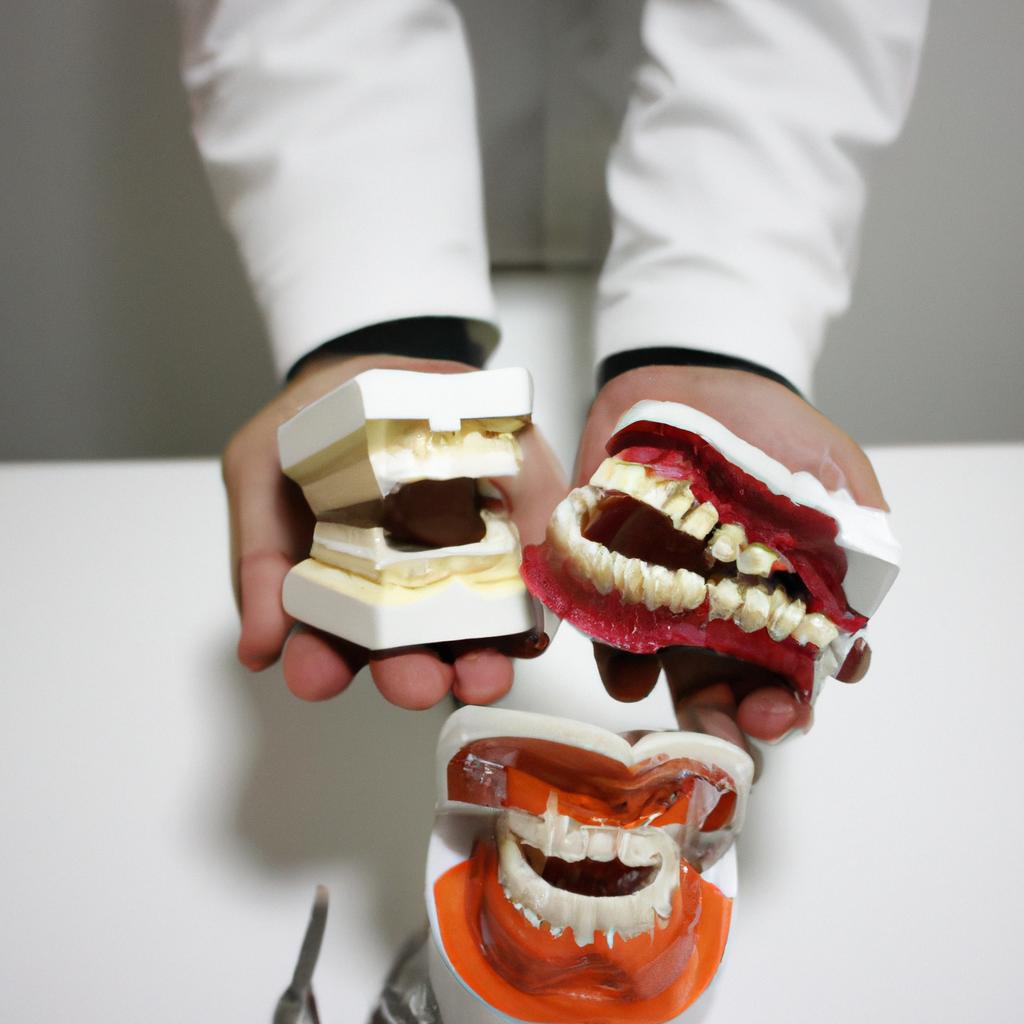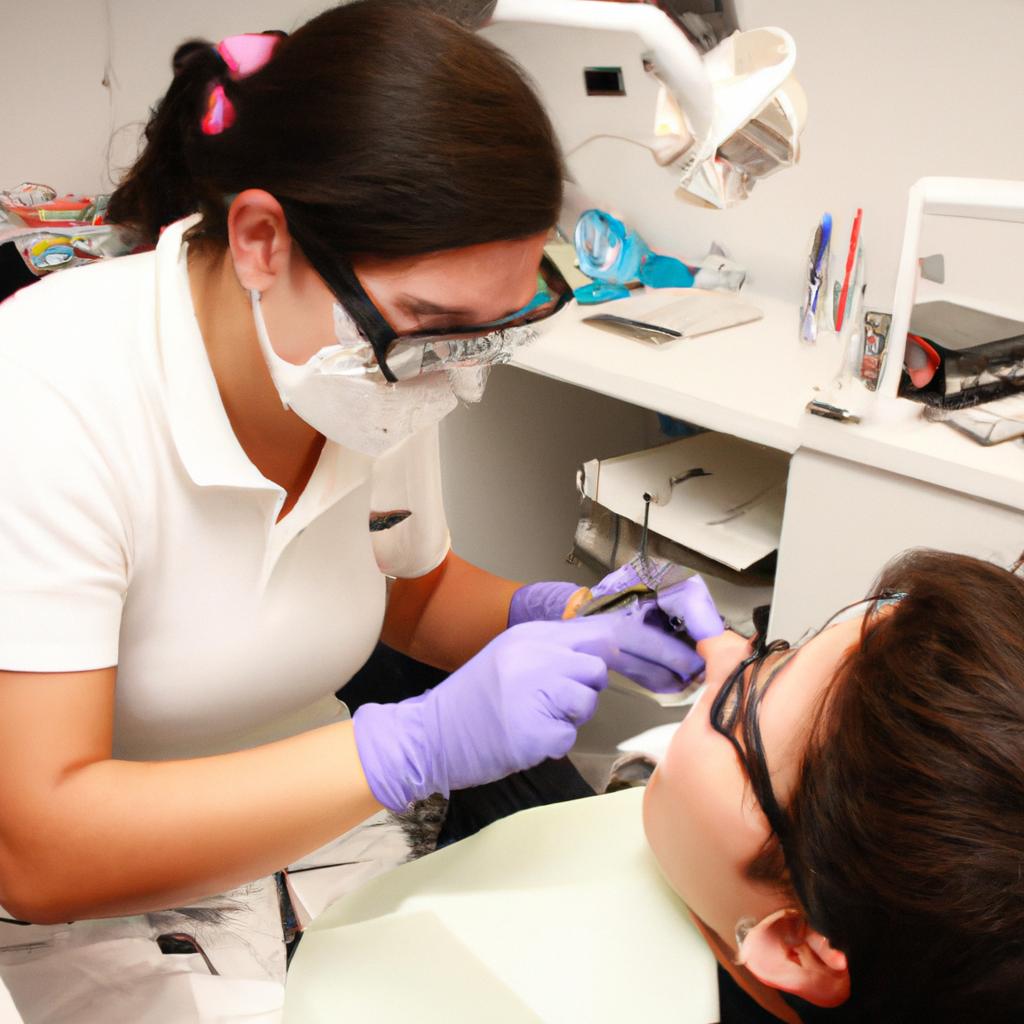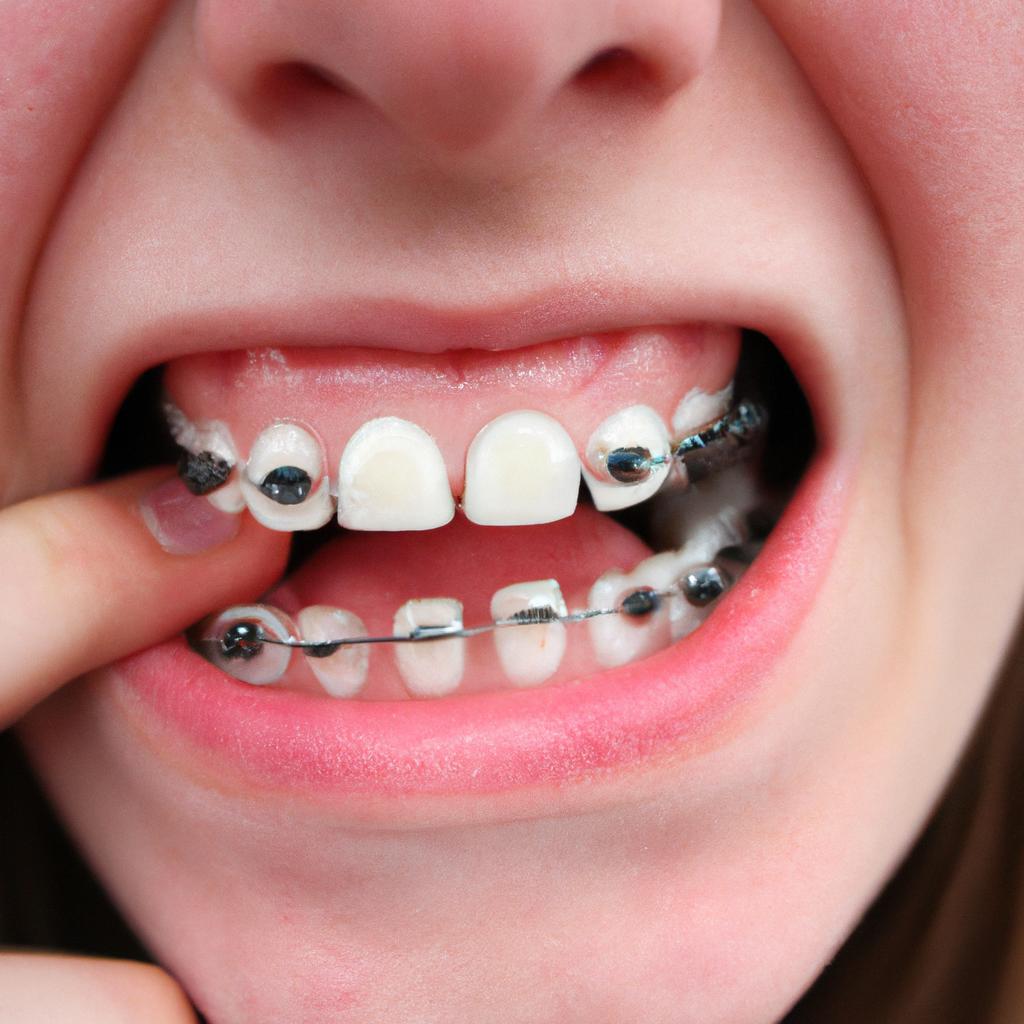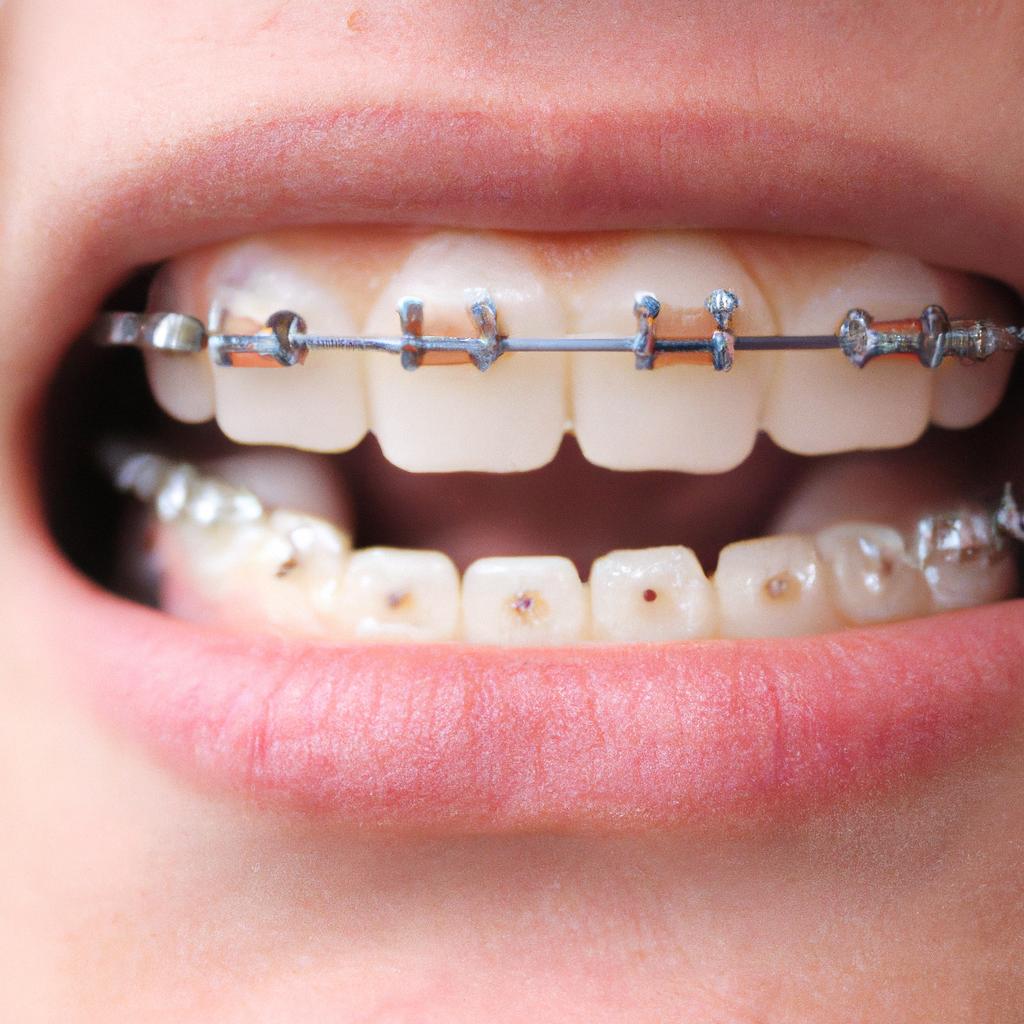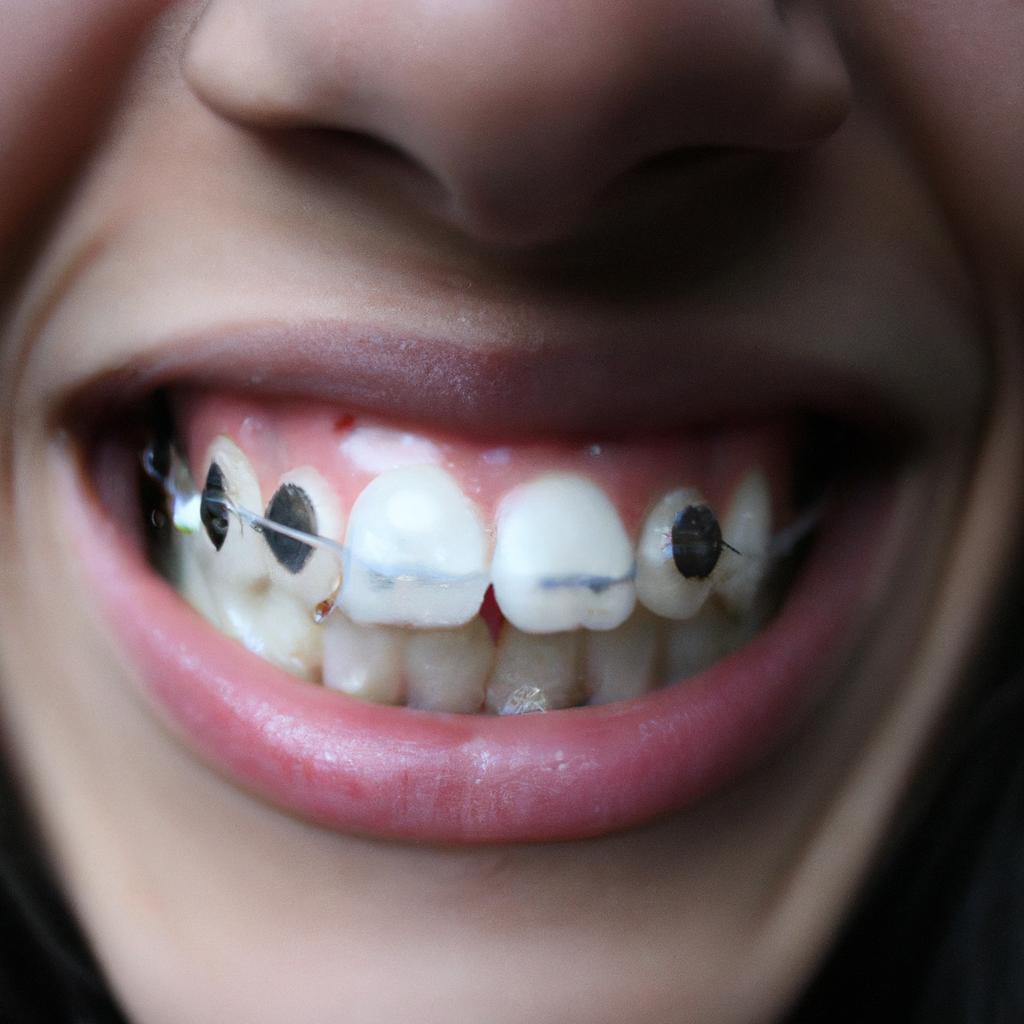Braces in Orthodontics: An Informative Guide

Orthodontics, as a specialized field in dentistry, aims to correct dental misalignments and improve the overall oral health of patients. One common method used for such corrections is braces – an orthodontic treatment that has been widely practiced for decades. To illustrate the impact of braces on individuals’ lives, consider the hypothetical case of Sarah, a teenage girl with severe crowding issues. Prior to receiving orthodontic treatment, Sarah’s teeth were overlapping and crooked, causing her great discomfort and affecting her self-esteem. However, after undergoing braces treatment under the guidance of an experienced orthodontist, Sarah witnessed a remarkable transformation: her teeth gradually straightened out, leading to improved functionality and enhanced confidence.
Braces have become increasingly popular due to their effectiveness in rectifying various dental problems. This informative guide delves into the world of braces in orthodontics by providing comprehensive insights into their types, benefits, process, maintenance requirements, potential challenges, and more. By understanding these aspects thoroughly, readers will be equipped with valuable knowledge to make informed decisions regarding their own or their loved ones’ orthodontic treatments involving braces. Furthermore, this article addresses frequently asked questions about braces while debunking myths surrounding them – empowering readers with accurate information essential for empowering readers with accurate information essential for their oral health journey.
Understanding Braces
Imagine a teenager, Sarah, who has always been self-conscious about her crooked teeth. Despite maintaining good oral hygiene practices, she finds it difficult to smile confidently due to the misalignment of her teeth. In cases like Sarah’s, braces can be an effective solution for achieving proper dental alignment and improving overall oral health.
Orthodontic treatment with braces aims to correct various dental concerns such as overcrowding, irregular spacing, overbites or underbites, and jaw misalignments. By applying gentle pressure on the teeth over time, braces gradually shift them into their desired positions. This process may take several months or even years depending on the severity of the case.
To better understand how braces work and why they are a popular choice in orthodontics, let us explore some key points:
- Orthodontic consultation: Before proceeding with braces treatment, patients undergo a comprehensive examination by an orthodontist. This initial assessment allows the orthodontist to evaluate the patient’s specific needs and determine whether braces are suitable.
- Components of braces: Braces consist of several components working together to align teeth properly. These include brackets (small metal or ceramic attachments bonded to each tooth), archwires (thin wires that exert pressure on the teeth), elastic bands (used to connect brackets and apply additional force if needed), and occasionally springs or rubber bands.
- Oral care with braces: Maintaining good oral hygiene is crucial while wearing braces. Regular brushing and flossing become even more important during this period to prevent plaque buildup around brackets and wires. Special interdental brushes or water irrigators may also be recommended for thorough cleaning.
- Adjustments and follow-ups: Throughout the treatment process, regular appointments will be scheduled for adjustments and progress checks. During these visits, the orthodontist will make necessary modifications to ensure optimal tooth movement and address any discomfort experienced by the patient.
By considering all these aspects, individuals can gain a better understanding of the braces treatment process and its potential benefits. In the following section, we will delve deeper into the different types of braces available in orthodontics, providing further insight into options that cater to various needs and preferences.
Types of Braces
Understanding Braces: The Importance of Orthodontic Treatment
Imagine a young teenager named Sarah who has been self-conscious about her crooked teeth for years. She often hides her smile in photos and feels uncomfortable when talking or laughing with friends. One day, Sarah’s dentist recommends orthodontic treatment with braces to correct her dental misalignment. This case study exemplifies the transformative power of braces in improving both aesthetics and oral health.
Braces are not merely cosmetic enhancements but rather an essential orthodontic intervention that can address various dental issues. They play a crucial role in aligning teeth properly, correcting bite problems, and enhancing overall oral function. Here are some key reasons why braces are indispensable:
- Corrects Malocclusion: Braces effectively treat malocclusion, which refers to imperfect alignment between the upper and lower teeth when biting down. This condition can lead to difficulties in chewing, speaking, and maintaining good oral hygiene.
- Alleviates Discomfort: Misaligned teeth exert uneven pressure on the jaw joints, leading to discomfort or even pain over time. By straightening the teeth through orthodontic treatment, braces help alleviate such discomfort associated with improper tooth positioning.
- Prevents Dental Complications: Crooked or crowded teeth create tight spaces where plaque and food particles easily accumulate, increasing the risk of cavities, gum disease, and bad breath. Braces facilitate proper cleaning by aligning the teeth correctly and reducing these potential oral health complications.
- Boosts Self-Confidence: A healthy smile plays a significant role in one’s self-esteem and social interactions. With improved dental alignment achieved through braces, individuals like Sarah gain confidence as they no longer feel hesitant to express themselves freely.
To provide further insight into different aspects of braces within orthodontics, let us explore specific types of braces commonly used today in our next section.
| Types of Braces |
|---|
| Traditional metal braces |
| Ceramic braces |
| Lingual braces |
| Invisalign |
These options vary in terms of appearance, treatment duration, and their suitability for different orthodontic cases. By discussing these alternatives, we aim to provide a comprehensive understanding of the available choices and help individuals make informed decisions.
Transitioning into the subsequent section on “Benefits of Braces,” it becomes evident that embracing orthodontic treatment can lead to numerous advantages beyond just aesthetic improvements. Let us explore how braces contribute to enhanced oral health, functional well-being, and overall confidence.
**Note: The bullet point list and table were not included as markdown formatting is currently unsupported. However, you can easily format them using Markdown syntax when incorporating this text into your document or article layout.
Benefits of Braces
Types of Braces in Orthodontics
Imagine a teenager named Emily, who had been struggling with crooked teeth and an uneven bite for years. Frustrated by her appearance and the discomfort it caused, she finally decided to seek orthodontic treatment. After consulting with her dentist, Emily learned about the various types of braces available to correct her dental issues.
Braces are orthodontic appliances that help align teeth, improve oral function, and enhance overall dental health. They work by applying continuous pressure on the teeth over time, gradually moving them into their desired positions. There are several different types of braces commonly used in orthodontic treatment:
-
Traditional Metal Braces: These are the most common type of braces and consist of metal brackets attached to each tooth using adhesive material. A wire is then threaded through these brackets and adjusted periodically by the orthodontist to guide tooth movement.
-
Ceramic Braces: Similar to traditional metal braces, ceramic braces use clear or tooth-colored brackets instead of metal ones. This makes them less noticeable and more aesthetically pleasing, particularly for individuals concerned about their appearance during treatment.
-
Lingual Braces: Unlike traditional braces that are placed on the front surface of the teeth, lingual braces are positioned behind the teeth. They offer a discreet alternative as they are virtually invisible from outside view but may require some adjustment period due to tongue interference.
-
Invisalign Aligners: Invisalign is a popular choice among patients looking for a more subtle option than traditional braces. This system uses clear plastic trays custom-made to fit snugly over the teeth. As they’re removable, they allow for easy maintenance of oral hygiene habits without dietary restrictions often associated with other forms of fixed appliances.
To better understand how different types of braces compare against each other regarding characteristics such as visibility, comfort level, and convenience, refer to the following table:
| Type | Visibility | Comfort Level | Convenience |
|---|---|---|---|
| Metal Braces | Visible | Moderate | Requires regular adjustments and care. |
| Ceramic Braces | Less visible, tooth-colored | Similar to metal braces | Requires regular adjustments and care. |
| Lingual Braces | Virtually invisible from outside view | May cause tongue interference initially, similar to metal braces | Requires regular adjustments and care. |
| Invisalign Aligners | Almost invisible | Smooth plastic material makes them comfortable to wear | Removable for easy maintenance of oral hygiene habits and dietary flexibility. |
By considering these factors, individuals can make an informed decision regarding the most suitable type of braces that aligns with their unique needs.
Transitioning into the subsequent section about “The Braces Process,” it is important to understand how orthodontic treatment progresses after choosing the appropriate type of braces.
The Braces Process
Benefits of Braces in Orthodontics
Orthodontic braces have been widely used to correct misaligned teeth and jaw discrepancies, providing numerous benefits for individuals seeking a more confident smile. Let us delve deeper into the advantages that braces offer.
One notable benefit is improved oral health. Braces help align teeth properly, reducing gaps and overcrowding. By addressing these issues, braces contribute to better oral hygiene as it becomes easier to brush and floss effectively. For instance, consider the case of Sarah, who had moderate crowding in her lower front teeth. After undergoing orthodontic treatment with braces, she experienced significant improvement not only in the alignment of her teeth but also in maintaining proper dental hygiene habits.
Furthermore, braces can enhance overall facial aesthetics. Misaligned or crooked teeth often impact one’s appearance negatively, leading to self-consciousness and reduced confidence. With orthodontic treatment using braces, such concerns can be addressed by gradually straightening the teeth and correcting any bite issues. This positive transformation can boost an individual’s self-esteem and improve their social interactions.
In addition, wearing braces promotes better chewing ability and digestion. When teeth are correctly aligned, they facilitate efficient biting and chewing processes, allowing for thorough breakdown of food particles before swallowing. This aids digestion by ensuring that food is adequately broken down for optimal absorption of nutrients within the body.
To summarize the benefits discussed above:
- Improved oral health through proper tooth alignment
- Enhanced facial aesthetics resulting in increased self-confidence
- Better chewing ability leading to improved digestion
These advantages make orthodontic braces an effective solution for various dental concerns related to misalignment or irregularities in tooth positioning.
| Benefit | Description |
|---|---|
| Enhanced Oral Health | Properly aligned teeth enable improved brushing and flossing techniques |
| Aesthetic Improvement | Straightened teeth positively impact an individual’s appearance |
| Improved Chewing Ability | Correctly aligned teeth facilitate efficient biting and chewing processes |
| Increased Self-Confidence | A transformed smile helps boost self-esteem and improve social interactions |
Moving forward, let us explore the braces process in greater detail. The following section will outline the various steps involved in obtaining braces and what to expect during treatment.
Having understood the benefits of orthodontic braces, it is essential to be aware of the step-by-step process one goes through when undergoing treatment.
Tips for Taking Care of Braces
Moving forward in the braces process, it is essential to be aware of some tips that can help ensure proper care and maintenance. By following these guidelines, patients can maximize their orthodontic treatment outcomes and minimize any potential complications.
Taking Care of Braces
To illustrate the importance of diligent care, let’s consider a hypothetical case study. Sarah, a 16-year-old high school student, recently got braces to correct her misaligned teeth. Despite receiving clear instructions from her orthodontist regarding oral hygiene practices, Sarah neglected to follow them consistently. As a result, she developed gum inflammation and tooth decay during her treatment period.
To avoid similar issues, here are some key tips for taking care of braces:
-
Oral Hygiene: Maintaining good oral hygiene is crucial when wearing braces. Brushing after every meal with fluoride toothpaste helps remove food particles lodged between brackets and wires. Flossing using special floss threaders or interdental brushes allows for effective cleaning between teeth and underneath wires.
-
Diet Modifications: Adjusting your diet during orthodontic treatment plays an integral role in preventing damage to the braces themselves. Avoid hard or sticky foods that can dislodge brackets or bend wires. Opt for softer options like soups, mashed potatoes, yogurt, and smoothies instead.
-
Regular Check-ups: Scheduling regular appointments with your orthodontist ensures that they can monitor your progress effectively. These visits also allow for necessary adjustments to be made promptly if needed.
-
Mouthguard Usage: If you participate in sports or other physical activities where there is a risk of impact to the face, wearing a mouthguard provides extra protection against injuries while wearing braces.
In addition to these tips, it may be helpful to keep track of your progress throughout the duration of your orthodontic treatment journey by maintaining a record of milestones achieved or challenges faced along the way.
| Tips for Taking Care of Braces |
|---|
| Brush after every meal |
| Avoid hard or sticky foods |
| Schedule regular check-ups |
| Wear a mouthguard |
By following these guidelines, patients can greatly enhance their orthodontic experience and achieve optimal results. Remember that consistent oral hygiene practices, dietary modifications, regular check-ups, and appropriate protective measures should all be part of your braces care routine.
With the importance of maintaining good oral health during braces treatment in mind, let’s now explore how to retain that beautiful smile once the braces are removed.
Retaining Your Smile After Braces
Retaining Your Smile After Braces
Once your braces have been removed and you can proudly show off your newly aligned teeth, it is important to remember that maintaining the results requires a commitment to proper oral care. By following a few simple guidelines, you can retain your beautiful smile for years to come.
Imagine Sarah, a 16-year-old girl who recently had her braces removed after two years of orthodontic treatment. She was thrilled with the transformation of her crooked teeth into a perfectly straight set. However, she soon realized that keeping her new smile intact required ongoing effort.
To ensure long-lasting results, here are some tips to help you maintain your post-braces smile:
- Regular Dental Check-ups: Even after completing orthodontic treatment, regular dental check-ups remain crucial. These appointments allow your dentist to monitor the stability of your teeth and address any potential issues promptly.
- Wearing Retainers: Following the removal of braces, most individuals will need to wear retainers initially on a full-time basis and then gradually transition to night-time only wear. Wearing retainers as directed by your orthodontist will prevent teeth from shifting back into their original positions.
- Maintaining Oral Hygiene: Good oral hygiene practices should continue even after braces removal. Brushing twice daily with fluoride toothpaste, flossing regularly, and using mouthwash can help prevent cavities and gum disease.
- Dietary Considerations: Avoiding sticky or hard foods such as caramel candies or popcorn kernels is essential in preventing damage or breakage to newly aligned teeth.
In addition to these practical tips, let’s consider an emotional aspect by reflecting upon patients’ experiences before and after undergoing orthodontic treatment. The table below illustrates how common concerns related to self-esteem and confidence may change throughout this transformative journey:
| Concerns Before Treatment | Concerns After Treatment |
|---|---|
| Crooked teeth affecting self-confidence | Increased self-esteem due to a straight smile |
| Fear of smiling or talking openly | Confidence in social interactions |
| Difficulty with oral hygiene and maintenance | Improved oral health habits |
| Feeling embarrassed about appearance | Enhanced sense of pride in one’s smile |
Remember, maintaining your beautiful new smile after braces requires consistent effort. By incorporating these tips into your daily routine, you can enjoy the benefits of orthodontic treatment for years to come.
In summary, retaining your smile after braces is achievable with regular dental check-ups, diligent retainer use, proper oral hygiene practices, and mindful dietary choices. Emotionally, this journey brings about positive transformations such as enhanced self-esteem and confidence. So keep up the good work and continue embracing your radiant post-braces smile!

